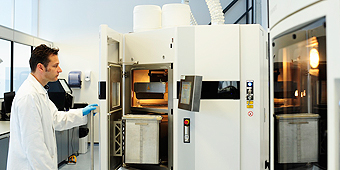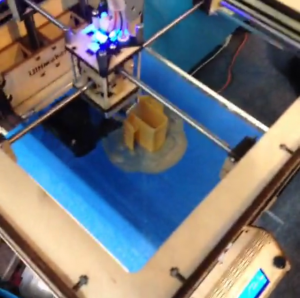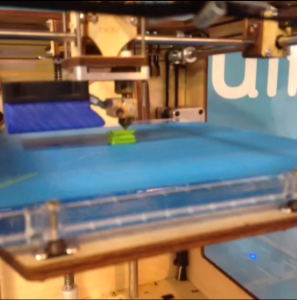
November 7, 2013, by Ben Read
An almost interesting dissertation…
The Dissertation, the 10000 word monster that lurks waiting for you in 3rd year, ready to consume all your time and energy! The funny thing about dissertations is that they are such personal and complex bits of work that nobody understands anybody else’s dissertation. I am in the midst of tackling this monster and as someone told me they almost found my topic interesting this week, I thought some of you might too!

A 3D printer at work
The wonders of 3D printing are becoming increasingly common knowledge thanks to the press and media singing its praises. I first came across this technology in a Business School module I took in my 2nd year. The University is actually a leader in this field and recently had 3D printed pieces go on display at the Science Museum in London. My lecturer told me many facts about 3D printing and the benefits it will bring:
- Things will no longer be produced in factories around the world but will be printed off wherever the demand is for them
- Everyone will have a 3D printer on their desk, just like an inkjet printer
- You’ll be able to print anything, including human skin and organs
- It is as cheap to produce one item as it is to produce a million, customization and personalisation is therefore possible
- Things will therefore be transported electronically meaning less oil consumption and less greenhouse gas emission, which will save the planet
- 3D printing gives greater material utilisation so there will be less wastage, again saving the planet
I may have simplified and shortened the list of benefits ever so slightly, but you get the gist of it, ‘3D printing is going to change the world’. I was swept up in this revolutionary wave and next thing you know I am writing my dissertation on it. Well actually, because I do Geography I am writing my dissertation on the location of 3D printing service providers, the location and industry of their clients and the hype surrounding the technology. Essentially, not the exciting stuff!

A 3D printed guitar
However, through conducting my research, which has involved interviewing industry experts and the people running the 3D printing companies, all is not as it seems. It appears some of the benefits mentioned above were slightly over-exaggerated or won’t materialise for a long, long time. Here are some quotations from the interviews to emphasise this point…
“Every angle of 3D printing isn’t as good as what people make it out to be”
“Everyone in the industry has the same opinion and everyone outside the industry thinks it’s going to be the future.”
And my favourite quotation,
“People are saying it’s going to be the future and that by 2020 its going to be 5 billion dollar industry, which is only a 3rd of the size of the processed sliced cheese industry in America, so it is tiny!”

A 3D printed version of De Gea and Evra
It appears safe to say that industry experts aren’t as optimistic as the press. They work with the technology day-to-day, they know how it really works and what is possible and what isn’t. It seems strange having people behind a technology trying to dampen the hype so much and perhaps that reinforces their point.
Having said all this and been the depressing whistle-blower, there is potential for 3D printing to affect the way business is done in the future. It will never replace mass production, but it may be useful for a company like Dyson for example to have an online inventory of spare parts which can be printed whenever needed, rather than storing millions of spare parts that could potentially never be used.

Another 3D printer at work
I hope I have given you a more realistic insight into the world of 3D printing. I believe the hype has peaked and people are starting to take a more critical view of the technology and as for the future we will have to wait and see…

3D holds a lot more for education than is realised. I want to focus on teaching aids in the classroom. With cheaper and more accessible 3D printing resources, this critical aspect of education becomes more responsive to the specific needs of each context. I believe if cheap and easily accessible 3D printing facilities are introduced into Africa, it will have a hyper effect because of the existence of mobile and wireless internet and this will catch on more than mobile phones did in the past. Institutions in Africa are starving for teaching aids so, the ball is really in the court of 3D manufacturers because the consumers are waiting.
That is an interesting area and perhaps doesn’t get the attention it deserves during discussions of 3D printing. However, the technology is still slow to print and the cheap printing facilities you talk of generally speaking only print in one material, plastic. Perhaps this would still be beneficial to institutions in Africa and the manufacturers have failed to pick up on this potentially large customer base.